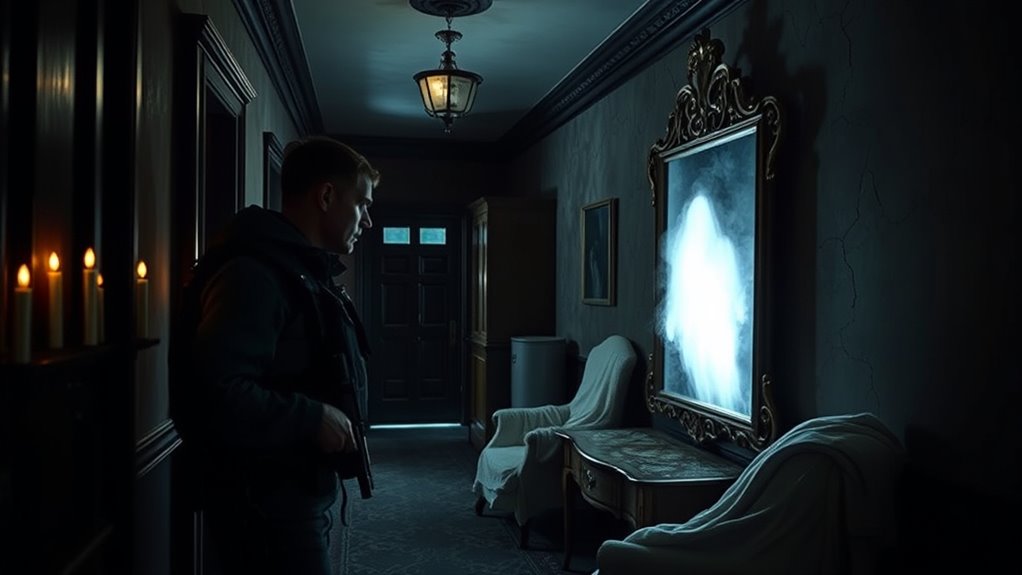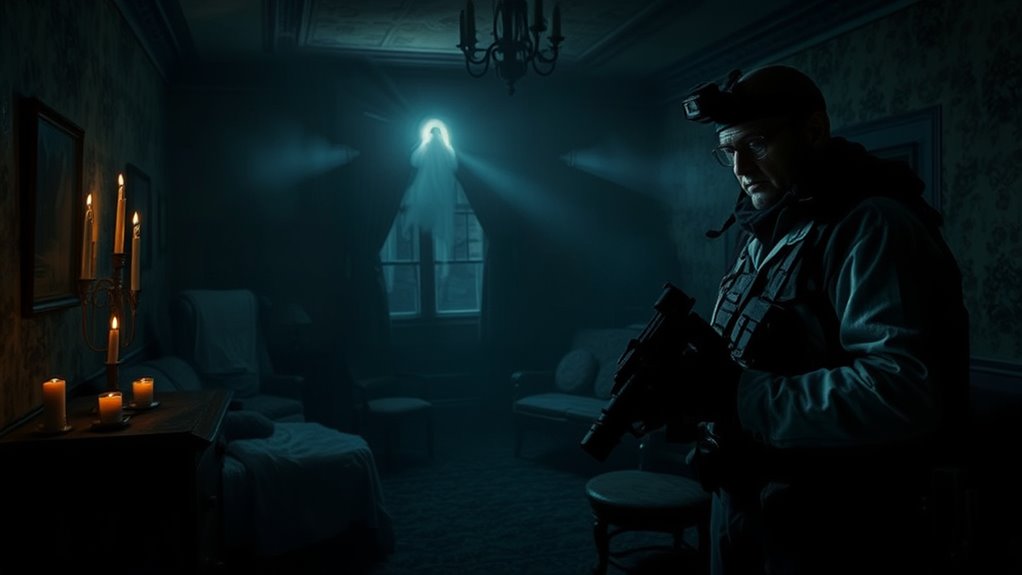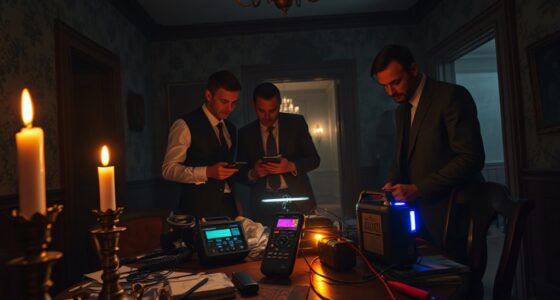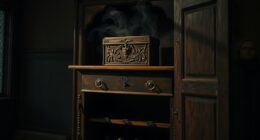A typical day in your life as a ghost hunter involves preparing your equipment like EMF meters, digital recorders, and thermal cameras, ensuring everything is calibrated and ready for action. You arrive at locations, carefully setting up devices near key spots like doorways or historic areas, scanning for activity. Throughout the investigation, you stay alert for unusual signs, recording every detail. Your dedication and equipment setup are essential—if you keep going, you’ll uncover more about the mysteries lurking in the unseen.
Key Takeaways
- Preparing and planning by reviewing location details and calibrating equipment for accurate readings.
- Setting up devices strategically in areas with potential paranormal activity, like doorways or cold spots.
- Conducting thorough observations and capturing data through audio, video, and environmental sensors.
- Monitoring device functionality and adjusting settings to optimize detection during investigations.
- Reviewing recordings and data afterward to identify anomalies indicating possible paranormal presence.

Every morning, a ghost hunter prepares for a day filled with mystery and investigation. You start by reviewing your plans, checking the locations you’ll visit, and mentally preparing for what might unfold. Once you’re ready, you gather your essential tools—EMF meters, digital recorders, thermal cameras, and spirit boxes—laying them out carefully to guarantee quick access during the day’s paranormal investigations. Equipment setup becomes your first task, and you move with purpose, calibrating devices and testing each piece to ensure they’re functioning properly. You know that reliable equipment can make all the difference when capturing unexplainable phenomena, so you double-check batteries and settings before heading out.
As you arrive at your first location, you scan the environment, looking for signs of activity or spots that might harbor spirits. You set up your equipment in strategic areas—near windows, doorways, or places with historical significance—aiming to maximize your chances of detecting paranormal activity. You know that equipment setup isn’t just about placing devices randomly; it’s about understanding the space, its history, and where energy might be concentrated. You position your thermal cameras to catch cold spots and flickering lights or shadows that could indicate unseen presences. Your digital recorders are placed in quiet corners, ready to capture any EVPs (Electronic Voice Phenomena) that might reveal voices from beyond. Additionally, understanding cultural and regional breakfast traditions can sometimes offer insights into local histories and stories, enriching your investigation context. You also recognize the importance of sensor calibration, which ensures your devices provide accurate readings crucial for analyzing potential paranormal signals. Proper calibration reduces measurement errors, making your data more trustworthy and meaningful. Furthermore, staying informed about vetted safety protocols helps you conduct your investigations securely and responsibly, minimizing risks during your work.
While you work, you stay alert, observing every movement, sound, or anomaly with sharp focus. Your equipment becomes an extension of your senses, helping you notice subtle signs that your eyes might miss. You’re aware that paranormal investigations demand patience and precision. As you move through the space, you adjust your devices if needed, making sure they’re capturing the best possible data. Sometimes, you’ll hear a faint whisper or see a sudden cold draft—moments that keep your heart racing and motivate you to dig deeper. Your training teaches you to remain objective, trusting your equipment but also your instincts. Developing a methodical approach can significantly enhance your ability to distinguish genuine phenomena from false alarms.
Throughout the day, you document your findings carefully, noting down times, locations, and any unusual occurrences. After packing up your gear, you review recordings and data, searching for anomalies that could indicate paranormal activity. It’s a meticulous process, but one that fuels your passion for uncovering the unknown. As you leave each site, you feel a mix of excitement and anticipation for what the next investigation might bring. Your day ends with the satisfaction of having chased mysteries hidden in the shadows, knowing that your equipment setup and dedication are essential in revealing the unseen world around you.
Frequently Asked Questions
What Equipment Do Ghost Hunters Use Most Frequently?
You mostly rely on equipment like EMF meters, digital voice recorders, and infrared cameras. These tools help detect electromagnetic fluctuations, capture ghostly voices, and record paranormal activity. You also perform spiritual rituals and conduct historical research to better understand the location’s background. Combining this equipment with your rituals and research enhances your chances of uncovering spirits and understanding their stories, making your investigations thorough and effective.
How Do Ghost Hunters Handle Fear During Investigations?
Imagine hearing a sudden whisper in the darkness—fear management becomes essential. You focus on adrenaline control by deep breathing, grounding yourself in the moment. You remind yourself that most fears are psychological, not supernatural. Staying calm helps you observe objectively, preventing panic from clouding your judgment. With steady nerves, you continue your investigation, trusting your training and instincts to handle fear and keep your mind clear amidst the shadows.
What’S the Most Common Location for Ghost Sightings?
You’ll find that the most common locations for ghost sightings are historical haunted sites and places tied to urban legend origins. These locations often have rich histories and stories that attract paranormal activity. When you investigate, you notice that old buildings, abandoned houses, and legendary landmarks are prime spots. The stories and legends surrounding these sites keep them popular among ghost hunters, making them ideal for exploring the mysteries of the afterlife.
Do Ghost Hunters Ever Encounter Dangerous Spirits?
Yes, you can encounter dangerous spirits during your investigations. To stay safe, you rely on spiritual protection techniques like protective charms and rituals. Be cautious around haunted objects, as they can harbor negative energies or spirits. Remaining respectful and prepared helps you avoid potential harm, and always trust your instincts. Proper knowledge and spiritual safeguards are essential for traversing risky encounters with spirits.
How Do Ghost Hunters Differentiate Hoaxes From Real Phenomena?
When you try to differentiate hoaxes from real paranormal phenomena, you rely on a blend of paranormal skepticism and scientific validation. You scrutinize evidence carefully, looking for inconsistencies or tricks, and use tools like EMF meters and cameras to verify claims. You also consider natural explanations first, ensuring that your findings aren’t just illusions or staged. This method helps you separate genuine experiences from deceptive or mistaken reports.
Conclusion
As your day ends, you realize you’re like a modern-day explorer, chasing shadows and whispers in the dark. Every creak and flicker has told its story, and you’ve been the silent witness. Ghost hunting isn’t just about fear; it’s about uncovering mysteries hiding behind the veil of the unknown. As you pack up, remember—you’ve danced with spirits and uncovered secrets, making you a brave explorer in a world where darkness hides the truth.









